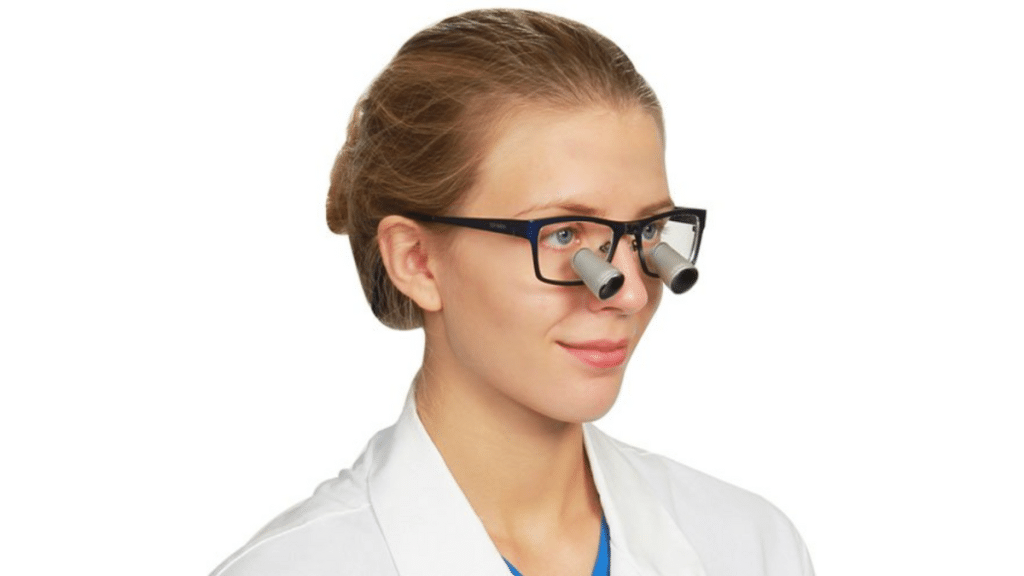Using dental loupes and headlights can significantly enhance precision, reduce eye strain, and improve posture for dental professionals. However, incorrect usage can lead to discomfort, reduced efficiency, and even long-term health issues. Understanding the common mistakes when using dental loupes will help you maximize their benefits and avoid unnecessary complications.
Mistakes to Avoid When Using Dental Loupes and Headlights
1. Choosing the Wrong Magnification
Selecting the appropriate magnification is crucial for efficiency and accuracy. Many beginners make the mistake of choosing magnification that is either too high or too low. If the magnification is too high, it narrows the field of view, making it harder to focus. Conversely, if it’s too low, you may not get the necessary detail required for precise work.
How to Avoid This Mistake:
- Consult with an expert before purchasing dental loupes.
- Test different magnifications to determine what suits your needs.
- Start with a lower magnification (e.g., 2.5x) before moving to higher levels (e.g., 3.5x or 4.5x).
- Consider your specific dental procedures and choose a magnification that complements your work.
2. Poor Fit and Adjustment
An improper fit can lead to headaches, neck strain, and overall discomfort. If dental loupes and headlights do not align correctly with your eyes, they can cause unnecessary strain and negatively impact your posture.
How to Avoid This Mistake:
- Ensure that your dental loupes are customized for your interpupillary distance.
- Adjust the nose pad and temple arms for a secure and comfortable fit.
- If discomfort persists, consider working with a professional supplier like Schultz Loupes for a proper fitting session.
- Periodically reassess the fit of your loupes to accommodate any changes in posture or work habits.
3. Incorrect Working Distance
Your working distance is the space between your eyes and the patient’s mouth. If this distance is not properly measured, you may find yourself leaning too far forward or backward, leading to poor posture and musculoskeletal issues.
How to Avoid This Mistake:
- Measure your working distance carefully before purchasing dental loupes.
- Choose adjustable loupes that allow slight modifications to match your posture.
- Maintain an ergonomic sitting position while working.
- Consult an ergonomics specialist to ensure you maintain a neutral spine while using your loupes.
4. Ignoring the Importance of Headlight Positioning
A common mistake is using a headlight without properly adjusting its angle and brightness. If the light is misaligned, it can create unnecessary shadows or glare, reducing visibility and efficiency.
How to Avoid This Mistake:
- Adjust your headlight to match the focus of your dental loupes.
- Use a lightweight, well-balanced headlight to reduce strain.
- Opt for LED headlights with adjustable brightness settings to accommodate different procedures.
- Regularly check the alignment of your headlight to ensure optimal illumination.
5. Not Cleaning and Maintaining Your Equipment Properly
Failing to clean and maintain your dental loupes and headlights can lead to poor visibility, reduced lifespan, and potential hygiene issues. Dust, debris, and smudges on the lenses can impair clarity and cause unnecessary eye strain.
How to Avoid This Mistake:
- Clean the lenses with a microfiber cloth and lens cleaner regularly.
- Store your dental loupes in a protective case when not in use.
- Check for loose screws or misalignments periodically and fix them promptly.
- Ensure that the headlight is free from dust and obstruction for maximum clarity.
6. Using the Wrong Frame Type
Frames that are too heavy or improperly designed can lead to discomfort and fatigue. Some professionals opt for stylish frames without considering ergonomic benefits, which can result in pressure points and misalignment.
How to Avoid This Mistake:
- Choose lightweight yet durable frames.
- Ensure that the frame fits well on your face without slipping.
- Consider prescription-compatible dental loupes if you wear corrective lenses.
- Try different frame materials and styles to find the most comfortable option for extended use.
7. Failing to Adapt to New Equipment
Switching to dental loupes and headlights requires an adjustment period. Many professionals make the mistake of expecting immediate results and become frustrated when they struggle initially.
How to Avoid This Mistake:
- Practice regularly to get used to the new equipment.
- Start with short sessions and gradually increase usage time.
- Adjust settings as needed to improve comfort and clarity.
- Seek advice from colleagues or mentors who have experience using dental loupes.
8. Overlooking Battery Life and Charging Needs
Battery-powered headlights provide convenience, but forgetting to charge them can disrupt workflow. Some users also rely on low-quality batteries that fail to provide consistent brightness.
How to Avoid This Mistake:
- Invest in a high-quality battery pack with a long runtime.
- Establish a routine for charging your headlight after each workday.
- Keep a spare battery on hand for emergencies.
- Consider using a backup headlight in case of unexpected power loss.
9. Not Taking Breaks and Overusing Loupes
While dental loupes and headlights improve accuracy, overuse without breaks can lead to eye strain and fatigue. Prolonged usage without proper rest can cause discomfort and long-term vision problems.
How to Avoid This Mistake:
- Follow the 20-20-20 rule: every 20 minutes, look at something 20 feet away for 20 seconds.
- Take short breaks between procedures to relax your eyes.
- Blink frequently and use artificial tears if necessary to prevent dryness.
Conclusion
Using dental loupes and headlights correctly can greatly enhance your efficiency, comfort, and overall dental practice. By avoiding these common mistakes—such as choosing the wrong magnification, failing to maintain proper fit, neglecting maintenance, and overusing loupes—you can ensure a seamless experience with your equipment. Take the time to properly adjust and care for your dental loupes, and you’ll reap the benefits of improved precision and ergonomics for years to come.
By implementing these best practices, dental professionals can prevent unnecessary strain, improve posture, and maximize their investment in high-quality dental loupes and headlights.
